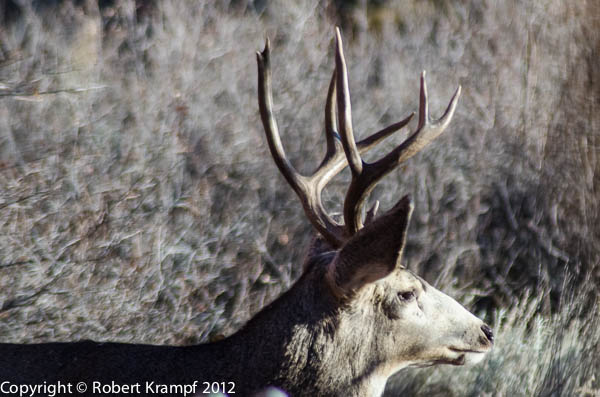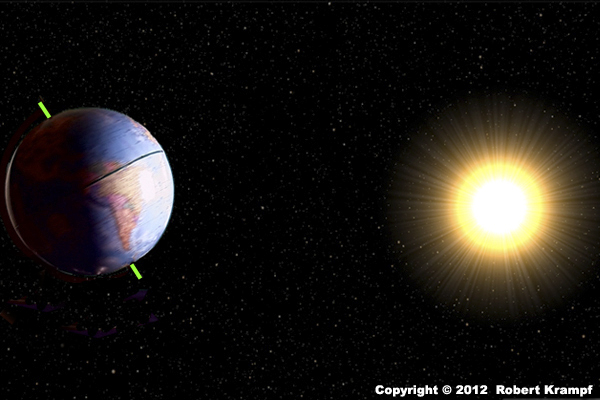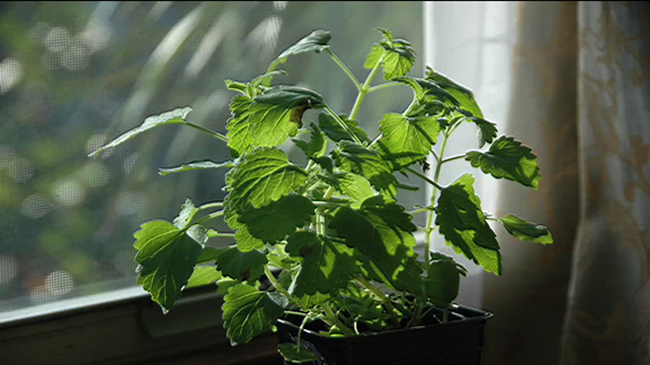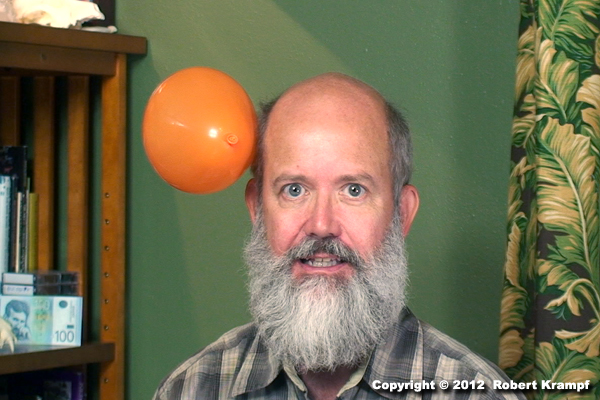Here are some science questions to help you test your general science knowledge. They will also show you which of the Florida, Utah, and NGSS science standards each question is testing.
The questions are chosen randomly, so this quest will be different each time.
Get 5 more random questions.
Would you rather see the most recently added questions?

Notice that the very back point on this Mule Deer's antlers is split. This is a genetic trait which is becoming more and more common because hunters would rather shoot deer with perfect antlers. This is an example of:
-
why hunting deer is a bad idea.
No. Actually, deer hunting is very important. Because we have killed off many of their natural predators, if hunters did not control their population, large numbers of them would starve to death. -
an adaptation that improves an organism's chance for survival.
Yes. Because hunters are less likely to shoot it, this deer is more likely to survive long enough to reproduce, passing this trait on to its offspring. -
an acquired trait.
No. This is a genetic trait, not an acquired trait. -
why antlers are more useful than horns.
No. Antlers and horns serve different functions, but both are useful to the animal that has them.
Click to see which state standards this question tests, and which of my videos, experiments, and other resources support that topic.
Florida
SC.5.L.15.1 Describe how, when the environment changes, differences between individuals allow some plants and animals to survive and reproduce while others die or move to new locations.
| Who Evolved on First? | text page, free, checked |
| Review Adaptation-1 | practice |
| Review Adaptation-5 | practice |
| Review Adaptation-6 | practice |
SC.7.L.15.2 Explore the scientific theory of evolution by recognizing and explaining ways in which genetic variation and environmental factors contribute to evolution by natural selection and diversity of organisms.
| Who Evolved on First? | text page, free, checked |
| Review Adaptation-1 | practice |
Utah
UT.5.V.2.c Describe how a particular physical attribute may provide an advantage for survival in one environment but not in another (e.g., heavy fur in arctic climates keep animals warm whereas in hot desert climates it would cause overheating; flippers on such animals as sea lions and seals provide excellent swimming structures in the water but become clumsy and awkward on land; cacti retain the right amount of water in arid regions but would develop root rot in a more temperate region; fish gills have the ability to absorb oxygen in water but not on land).
| Review Adaptation-1 | practice |
| Review Adaptation-5 | practice |
| Review Adaptation-6 | practice |
UT.7.IV.2.a Predict why certain traits (e.g., structure of teeth, body structure, coloration) are more likely to offer an advantage for survival of an organism.
| Selective Smelling | video, checked |
| Onion Crystals | video |
| Who Evolved on First? | text page, free, checked |
| Thoughts on an Exoskeleton | text page, free |
| Review Adaptation-1 | practice |
| Review Adaptation-2 | practice |
| Review Adaptation-5 | practice |
| Review Adaptation-6 | practice |
NGSS
3-LS4-2 Use evidence to construct an explanation for how the variations in characteristics among individuals of the same species may provide advantages in surviving, finding mates, and reproducing.
| Flowers | video, ClosedCaptions |
| Who Evolved on First? | text page, free, checked |
| Review Adaptation-1 | practice |
| Review Adaptation-3 | practice |
| Review Adaptation-4 | practice |
| Review Adaptation-5 | practice |
| Review Adaptation-6 | practice |

What season is Australia having in this graphic?
-
Spring
No. In the spring, the Earth's axis would not be tilted towards or away from the Sun. -
Summer
Yes! Australia is in the southern hemisphere, which is tilted towards the Sun. That tells us that it is summer there. -
Autumn
No. In the autumn, the Earth's axis would not be tilted towards or away from the Sun. -
Winter
No. Australia is in the southern hemisphere. If it was having winter, then the southern hemisphere would be tilted away from the Sun.
Click to see which state standards this question tests, and which of my videos, experiments, and other resources support that topic.
Florida
SC.4.E.5.1 Observe that the patterns of stars in the sky stay the same although they appear to shift across the sky nightly, and different stars can be seen in different seasons.
| Global Science | video, ClosedCaptions |
| Review Space-5 | practice |
| Review Space-8 | practice |
| Review Space-12 | practice |
SC.8.E.5.9 Explain the impact of objects in space on each other including: 1. the Sun on the Earth including seasons and gravitational attraction 2. the Moon on the Earth, including phases, tides, and eclipses, and the relative position of each body.
| Global Science | video, ClosedCaptions |
| Why is a Full Moon So Bright? | text page, free, checked |
| Review Space-13 | quest |
| Review Space-12 | practice |
Utah
UT.6.II.2.e Use a model to explain why the seasons are reversed in the Northern and Southern Hemispheres.
| Global Science | video, ClosedCaptions |
| Review Space-5 | practice |
| Review Space-8 | practice |
| Review Space-12 | practice |
NGSS
5-ESS1-2 Represent data in graphical displays to reveal patterns of daily changes in length and direction of shadows, day and night, and the seasonal appearance of some stars in the night sky.
| Global Science | video, ClosedCaptions |
| Finding Your Way | video, checked |
| Review Space-5 | practice |
| Review Space-8 | practice |
| Review Space-12 | practice |
MS-ESS1-1 Develop and use a model of the Earth-sun-moon system to describe the cyclic patterns of lunar phases, eclipses of the sun and moon, and seasons.
| Global Science | video, ClosedCaptions |
| Why is a Full Moon So Bright? | text page, free, checked |
| Review Space-6 | practice |
| Review Space-7 | practice |
| Review Space-9 | practice |
| Review Space-12 | practice |

I placed this plant near the window. After two hours, I examined it. What would you expect to happen to the leaves during that time?
-
The leaves will turn towards the light.
Yes. The leaves will move and turn so that their surface gets as much light as possible. The following is a time lapse video, showing what happened with the plant. -
The leaves will turn away from the light.
No. The leaves need light, so they turn to catch as much light as possible. -
The leaves will turn a darker green.
No. While more light could eventually cause the leaves to grow and darken, the process would not happen in a couple of hours. -
The leaves will not change.
No. Plants are adapted to turn their leaves towards a light source.
Click to see which state standards this question tests, and which of my videos, experiments, and other resources support that topic.
Florida
SC.3.L.14.2 Investigate and describe how plants respond to stimuli (heat, light, gravity), such as the way plant stems grow toward light and their roots grow downward in response to gravity.
| Review Plants-1 | practice |
SC.5.L.17.1 Compare and contrast adaptations displayed by animals and plants that enable them to survive in different environments such as life cycles variations, animal behaviors and physical characteristics.
| Flowers | video, ClosedCaptions |
| Onion Crystals | video |
| A Walk in the Park | video, checked |
| Nature Watching | video, checked |
| Calling a Woodpecker | video, checked |
| Selective Smelling | video, checked |
| Seed Search | video, ClosedCaptions, checked |
| Review Adaptation-3 | practice |
| Review Adaptation-4 | practice |
| Review Adaptation-5 | practice |
| Review Adaptation-6 | practice |
| Review Plants-1 | practice |
| Review Adaptation-2 | practice |
Utah
UT.8.IV.4.d Investigate and report the response of various organisms to changes in energy (e.g., plant response to light, human response to motion, sound, light, insects’ response to changes in light intensity).
| Making a Screamer | video, free, Updated |
| Review Plants-1 | practice |
UT.3.II.2.b Predict the effects of changes in the environment (e.g., temperature, light, moisture) on a living organism.
| Color Changing Flowers | video, checked |
| Weather and Climate | video |
| Review Plants-1 | practice |
UT.3.V.1.b Observe and report how sunlight affects plant growth.
| Measuring Photosynthesis | video, checked |
| Testing a Leaf for Starch | video, ClosedCaptions |
| Review Plants-1 | practice |
NGSS
2-LS2-1 Plan and conduct an investigation to determine if plants need sunlight and water to grow.
| Measuring Photosynthesis | video, checked |
| Testing a Leaf for Starch | video, ClosedCaptions |
| Review Plants-1 | practice |
3-LS3-1 Analyze and interpret data to provide evidence that plants and animals have traits inherited from parents and that variation of these traits exists in a group of similar organisms.
| Who Evolved on First? | text page, free, checked |
| Review Cells-4 | practice |
K-ESS2-2 Construct an argument supported by evidence for how plants and animals (including humans) can change the environment to meet their needs.
| Seed Search | video, ClosedCaptions, checked |
| Review Plants-1 | practice |
4-LS1-1 Construct an argument that plants and animals have internal and external structures that function to support survival, growth, behavior, and reproduction.
| Pumpkin Guts | video, free, ClosedCaptions, checked |
| Seed Search | video, ClosedCaptions, checked |
| Orange Slices | video, ClosedCaptions |
| Bird Bones | video, free |
| Feathers | video, checked |
| Heartless Plants | video, ClosedCaptions, checked |
| Nature Watching | video, checked |
| Calling a Woodpecker | video, checked |
| Thoughts on an Exoskeleton | text page, free |
| Eye Shine | text page |
| How Does a Butterfly Fly? | text page, free |
| Review Plants-3 | practice |
| Review Plants-1 | practice |
| Review Plants-5 | practice |
| Review Plants-6 | practice |
| Review Plants-7 | practice |
| Review Plants-8 | practice |
MS-LS1-5 Construct a scientific explanation based on evidence for how environmental and genetic factors influence the growth of organisms.
| Yeast and Sugar, part 2 | video, checked |
| Yeast and Sugar, part 1 | video, checked |
| Measuring Photosynthesis | video, checked |
| Color Changing Flowers | video, checked |
| Who Evolved on First? | text page, free, checked |
| Review Plants-1 | practice |

After I rubbed this ballon against my hair, it stuck to the side of my head. Why?
-
The balloon stuck because I don't have enough hair.
No. While much of my hair is gone, I still have enough to do this experiment. -
The balloon stuck because the balloon had the same charge as my hair.
No. Two things with the same electrostatic charge will repel, pushing apart. -
The balloon stuck because the balloon had a different charge from my hair.
Yes. When I rubbed the balloon against my hair, electrons moved from my hair to the balloon. The extra electrons gave the balloon a negative charge, and the missing electrons left my hair with a positive charge. Opposite charges attract, so the balloon stuck to my hair. -
The balloon stuck because my hair was magnetized.
No. Rubbing a balloon against something does not magnetize it. Even if it was magnetized, a magnet would not attract the rubber balloon.
Click to see which state standards this question tests, and which of my videos, experiments, and other resources support that topic.
Florida
SC.5.P.10.3 Investigate and explain that an electrically-charged object can attract an uncharged object and can either attract or repel another charged object without any contact between the objects.
>>> Teacher Page: Electrostatic Charges
| Making Water Wiggle | video |
| Challenge: Paper, Coin, Cup, part 1 | video |
| Electrostatic Charges | video |
| The Leyden Jar | video, checked |
| Versorium | video, checked |
| Electrostatics and Water | video, ClosedCaptions, checked |
| Challenge: Paper, Coin, Cup, part 2 | video |
| Sorting Salt and Pepper | video, checked |
| Electricity | video, free, Updated |
| Review Energy-6 | quest |
| Review Energy-7 | quest |
| Review Energy-8 | quest |
SC.6.P.13.1 Investigate and describe types of forces including contact forces and forces acting at a distance, such as electrical, magnetic, and gravitational.
| Light a Bulb with a Balloon | video, checked |
| Crushed Can | video, checked |
| Electricity | video, free, Updated |
| The Compass and Magnetic Fields | video, ClosedCaptions, checked |
| Challenge: Paper, Coin, Cup, part 1 | video |
| Making a Compass | video, checked |
| Torque | video |
| Versorium | video, checked |
| Water in a Glass, part 2 | video, checked |
| Water in a Glass, part 3 | video, checked |
| Water in a Glass, part 1 | video, checked |
| Challenge: Paper, Coin, Cup, part 2 | video |
| Review Energy-6 | quest |
| Review Energy-7 | quest |
| Review Energy-8 | quest |
Utah
UT.5.IV.1.c Describe the behavior of objects charged with static electricity in attracting or repelling without touching.
| Challenge: Paper, Coin, Cup, part 1 | video |
| Electrostatic Charges | video |
| The Leyden Jar | video, checked |
| Versorium | video, checked |
| Electrostatics and Water | video, ClosedCaptions, checked |
| Challenge: Paper, Coin, Cup, part 2 | video |
| Sorting Salt and Pepper | video, checked |
| Making Water Wiggle | video |
| Review Energy-6 | quest |
| Review Energy-7 | quest |
NGSS
MS-PS3-2 Develop a model to describe that when the arrangement of objects interacting at a distance changes, different amounts of potential energy are stored in the system.
| Electrostatics and Water | video, ClosedCaptions, checked |
| Challenge: Paper, Coin, Cup, part 2 | video |
| Sorting Salt and Pepper | video, checked |
| Making Water Wiggle | video |
| Measuring Kinetic and Potential Energy | video, checked |
| Challenge: Paper, Coin, Cup, part 1 | video |
| The Leyden Jar | video, checked |
| Versorium | video, checked |
| Water in a Glass, part 2 | video, checked |
| Water in a Glass, part 3 | video, checked |
| Water in a Glass, part 1 | video, checked |
| Review Energy-6 | quest |
| Review Energy-7 | quest |
| Review Energy-8 | quest |

This is a lichen, which is actually a fungus and an algae living together. As it grows, it produces chemicals which dissolve some of the rock it grows on. This is an example of:
-
Erosion
No. Erosion means that the pieces of rocks are being carried away. The lichen is dissolving the rock, but not carrying it away. -
Weathering
Yes! Lichens cause quite a bit of weathering in rocky areas. -
Both erosion and weathering
No. The rock is not being moved, so it is not erosion. -
Neither erosion nor weathering
No. As the lichen dissolves the rock, that is an example of weathering.
Click to see which state standards this question tests, and which of my videos, experiments, and other resources support that topic.
Florida
SC.4.E.6.1 Identify the three categories of rocks: igneous, (formed from molten rock); sedimentary (pieces of other rocks and fossilized organisms); and metamorphic (formed from heat and pressure).
| Bioclastics: Rocks With No Minerals | video |
| Evaporites | video, learnalong, checked |
| Igneous Rocks and Bubbles | video, free, learnalong, Updated |
| Sedimentary Rocks | video, learnalong |
| What is a Rock? | video, learnalong, checked |
| Foliated and Unfoliated Rocks | text page, learnalong |
| Identifying Igneous Rocks | text page, learnalong |
| Intrusive and Extrusive Igneous Rocks | text page, learnalong |
| Light and Dark Minerals | text page, learnalong |
| Homemade Fossil Dig | text page |
| Review Rocks-1 | practice |
| Review Rocks-2 | practice |
| Review Rocks-3 | practice |
| Review Rocks-4 | practice |
| Review Rocks-5 | practice |
| Review Rocks-6 | practice |
| Review Rocks-8 | practice |
| Review Rocks-9 | practice |
| Review Rocks-7 | practice |
| Review Rocks-10 | practice |
| Review Rocks-10 | practice |
| Review Rocks-10 | practice |
SC.7.E.6.2 Identify the patterns within the rock cycle and relate them to surface events (weathering and erosion) and sub-surface events (plate tectonics and mountain building).
| Bioclastics: Rocks With No Minerals | video |
| Weathering and Erosion | video, learnalong, checked |
| Evaporites | video, learnalong, checked |
| What is a Rock? | video, learnalong, checked |
| The Rock Cycle | video, learnalong |
| Change: Fast and Slow | video |
| Erosion | video, checked |
| Continuous Change | video, checked |
| Review Rocks-1 | practice |
| Review Erosion-1 | practice |
| Review Erosion-2 | practice |
| Review Erosion-3 | practice |
| Review Erosion-4 | practice |
| Review Erosion-5 | practice |
| Review Rocks-4 | practice |
| Review Rocks-5 | practice |
| Review Rocks-6 | practice |
| Review Rocks-8 | practice |
| Review Rocks-9 | practice |
| Review Rocks-7 | practice |
| Review Rocks-10 | practice |
| Review Rocks-10 | practice |
Utah
UT.4.III.2.b Distinguish between weathering (i.e., wearing down and breaking of rock surfaces) and erosion (i.e., the movement of materials).
| Change: Fast and Slow | video |
| Erosion | video, checked |
| Weathering and Erosion | video, learnalong, checked |
| Review Erosion-1 | practice |
| Review Erosion-2 | practice |
| Review Erosion-3 | practice |
| Review Erosion-4 | practice |
| Review Erosion-5 | practice |
UT.5.II.1.a Identify the objects, processes, or forces that weather and erode Earth’s surface (e.g., ice, plants, animals, abrasion, gravity, water, wind)
| Change: Fast and Slow | video |
| Erosion | video, checked |
| Continuous Change | video, checked |
| Weathering and Erosion | video, learnalong, checked |
| Review Erosion-1 | practice |
| Review Erosion-2 | practice |
| Review Erosion-3 | practice |
| Review Erosion-4 | practice |
| Review Erosion-5 | practice |
UT.8.III.2.b Describe the role of energy in the processes that change rock materials over time.
| Igneous Rocks and Bubbles | video, free, learnalong, Updated |
| Sedimentary Rocks | video, learnalong |
| Change: Fast and Slow | video |
| Erosion | video, checked |
| Continuous Change | video, checked |
| Weathering and Erosion | video, learnalong, checked |
NGSS
4-ESS2-1 Make observations and/or measurements to provide evidence of the effects of weathering or the rate of erosion by water, ice, wind, or vegetation.
| Change: Fast and Slow | video |
| Erosion | video, checked |
| Continuous Change | video, checked |
| Weathering and Erosion | video, learnalong, checked |
| Review Erosion-1 | practice |
| Review Erosion-2 | practice |
| Review Erosion-3 | practice |
| Review Erosion-4 | practice |
| Review Erosion-5 | practice |
The questions are chosen randomly, so this quest will be different each time.
